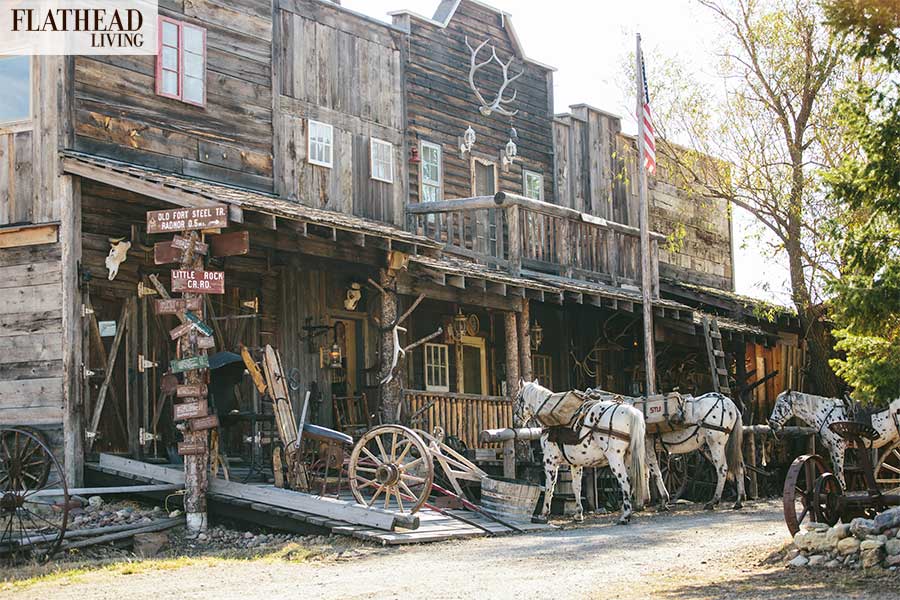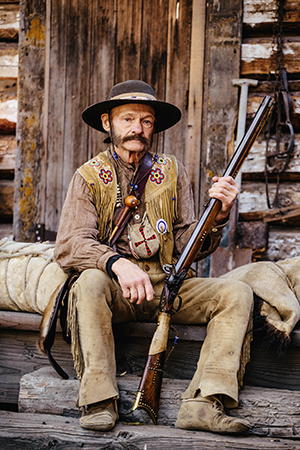Resurrecting the American Frontier
At the Bad Rock Settlement museum, Stu Sorensen provides a detailed glimpse of Northwest Montana as it was in the mid 1800s to early 1900s
By Clare Menzel | Photography by Mandy Mohler
As Stu Sorensen walks down the front porch of his living history museum, his fringe sways. There’s fringe down the sides of his buckskin pants, fringe on the chest of a Chippewa-Cree vest, which is also adorned with beautiful beadwork flowers and Russian blue trading beads. Underneath the vest: a bone-buttoned linen shirt, handmade by a friend to mimic a style popular in Montana in the mid 1880s. Sorensen also wears elk-hide moccasins, a beaver hat, a necklace strung with elk ivory and brass beads, and a full mustache.
He smiles, beckoning a group of visitors into his museum, called the Bad Rock Settlement. It sits on his Bad Rock Ranch property, near the foot of Columbia Mountain. The building’s nine themed rooms, each at least 15 by 15 feet in size, contain thousands of early Montana artifacts, antiques and vintage replicas. It’s all part of an extensive private collection that the 73-year-old has been acquiring for more than half a century.
“I love it and I enjoy it,” Sorensen says of collecting. “I want to portray the early days. The kids that come [to the museum], I say, ‘This is your great-grandparents, your great-great-grandparents.’ Where they lived. This is what they did to stay alive. How they survived. It’s part of their heritage.”
Sorensen built this museum eight summers ago, after his wife Peg, a retired math teacher, encouraged him to finally move his overwhelming collection out of their family home, where it had lived for decades. Peg joins him for the tour, as does their son, Shaun, who lives on the same property. Neither are in period garb; Peg is wearing a neon pink Cabela’s sweatshirt.
Sorensen says the rooms showcase different aspects of life for the settlers of Northwest Montana, ranging from the mid 1800s to early 1900s. One room represents a trapper cabin, the next is a trading post, and then there’s a mercantile, saloon, livery stable, cowboy bunkhouse, saddle shop, tribal camp, and lumberjack cabin.

First, Sorensen ushers his guests into the trapper cabin. Furs adorn the walls: muskrat, coyote, bear, beaver, ermine, martin. There’s a bison head. And an entire wardrobe of fur and buckskin. He points out a French knit hat, and explains how trappers stored their tobacco in its pointed, folded-down tip. He notes how he used to have 50 coats, but he’s winnowed that down.
“To 49 and a half?” Shaun jokes.
Sorensen picks up a tin with an embedded magnifying glass — it’s a Strike-A-Light kit. Containing flint and a char cloth, which is a swatch of easily ignitable fabric, it was effortlessly sealed watertight with a bit of bear grease rubbed around the edge. He demonstrates with the flint, flinging showers of sparks across the cabin.
Sorensen seals up the kit and draws attention to a hand-forged exact replica of tomahawks that the Lewis and Clark Expedition carried. It took a blacksmith friend of his 30 minutes to make. This exhibit’s walls are filled with antique firearms, hatchets and knives. Before moving on to the next room, Sorensen points out the Flathead Free Trapper’s Flag, representing early trappers who did not work for a company like Hudson’s Bay. The group is still around; Sorensen is a member. He’s also part of the Flathead Valley Muzzleloaders and the Back Country Horsemen.

The Free Trapper’s flag bears three symbols: the turtle, symbolizing “longevity and being tough,” which Sorensen says was inspired by Native American culture; the outline of indistinct peaks portraying the Rocky Mountains; and a fur press, a tall frame that old-time trappers would use to compress beaver pelts into 90-pound bundles. A visitor asks if he has one in his collection.
“No, but I should make one,” he says.
This museum is a “full-time thing” for Sorensen, who spends most of his time researching early Montana life, touching up unfinished rooms and improving all the exhibits. “Filling [the museum], it seems, is a constant process,” Peg jokes.
Before all this, Sorensen had many other careers. He started working at a young age: picking beans, milking cows and collecting bottles along the highway. During most of Sorensen’s childhood, his dad owned the now-shuttered Thunderbird Antique store in Columbia Falls. Sorensen helped out in the shop, but never earned any wages, because he couldn’t stop trading his labor for goods.
“I collected things that I thought represented pioneers and early Americans,” Sorensen says. “I lived the life. I trapped, I packed, guided, spent a lot of years in the mountains. That’s what I loved.”
“We always said he was born 100 years too late,” Peg says.
In the spring of 1965, Sorensen landed his first job as a packer out of Big Prairie in the Bob Marshall Wilderness. Later, he worked as a chief scout and guide for Spotted Bear Ranch, and also as a contract packer. He estimates that he traveled 8,000 miles during the 11 seasons he packed in Glacier National Park — and he claims to have never sored a mule, all those years. Artifacts from this career are stored in the museum.
Long before opening the museum, Sorensen was sharing his artifacts with students, locally and wherever else he’s invited. He has also been a model: for his painter friends and in advertisements for Microsoft and Black Star Brewing. He stars in the 2010 feature film Kravenhoof. His hands, beat up from years of packing, were once featured in a mountain climbing magazine.
“They wanted some gnarly hands. I used ‘em hard,” he says. “I did everything wide-open. I worked as hard as I could, as fast as I could. If you work hard, time goes fast. I like to be busy; I like to earn my money.”
Sorensen leads his guests into the next exhibit: the trading post. A glass case displays hundreds of beads, buttons, coins, and other trinkets.

“I like the little things,” Peg says, pointing out items in the case. “This is the sugar they used to carry. This is the tobacco they used to carry. He has a thing of hot chocolate that’s hard; they used to scrape it into hot water. That’s a brick of tea.”
The mercantile exhibit contains more period garments and hats, cooking utensils, shaving soap, a Bible, cornmeal, a vial of Black Hills gold, a Ravioli presser, and paintings by Western household names, including Ace Powell. Peg explains how she’d like to put tin on the ceiling, but she thinks she can make embossed wallpaper look good enough. As a painter, she has made significant contributions to the exhibits (the upstairs of the museum is her dedicated paint shop). In one room, she used sponge painting to create the appearance of tanned buckskin walls. “I’m really tickled, the way that came out,” Sorensen says.
Sorensen leads his visitors through the rest of the rooms, a bit more quickly than he’d like. “Every one’s got a story,” he says, taking stock of the artifacts in one exhibit. He says that the full tour takes about two hours, but it’s clear that he could go on forever, telling tall tales, imagining these artifacts in use, and inhabiting the sepia-toned memories from this early Montana way of life.
To schedule a tour at the Bad Rock Settlement, call (406) 249-8051. Sorensen charges $20 per person for small groups, but offers a discounted rate of $10 per person for larger groups of up to 15 people. Inquire to arrange a school program.